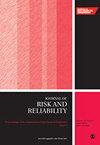Remaining useful life prediction of implicit linear Wiener degradation process based on multi-source information
IF 1.8
4区 工程技术
Q3 ENGINEERING, INDUSTRIAL
Proceedings of the Institution of Mechanical Engineers Part O-Journal of Risk and Reliability
Pub Date : 2022-11-19
DOI:10.1177/1748006x221132606
引用次数: 0
Abstract
Accurate remaining useful life (RUL) prediction is helpful to improve the reliability and safety of complex systems. However, in practical engineering applications, it often occurs imperfect or scarce prior degradation information for the degradation system with measurement error (ME). In order to solve this problem, based on the implicit linear Wiener degradation process, a RUL prediction method which reasonably fuses failure time data or multi-source information is proposed in this paper. Firstly, based on the implicit linear Wiener degradation process, we obtain the relationship between the natures of parameters estimation and degradation data by theoretical derivation, which provides a theoretical basis regarding how to fuse multi-source information. Secondly, according to the natures of parameters estimation, we use field degradation data and historical degradation data to estimate the fixed parameters of the two prediction cases respectively, and fuse failure time data into the degradation model by the expectation maximization (EM) algorithm. Then, the Kalman filtering algorithm is used to online update the drift parameter based on field degradation data. Finally, we use some simulation experiments to further verify the natures of parameters estimation, and two practical case studies to verify the superiority of the proposed method.基于多源信息的隐式线性维纳退化过程剩余使用寿命预测
准确的剩余使用寿命(RUL)预测有助于提高复杂系统的可靠性和安全性。然而,在实际工程应用中,对于具有测量误差(ME)的退化系统,往往会出现先验退化信息不完善或稀缺的情况。为了解决这一问题,本文基于隐式线性维纳退化过程,提出了一种合理融合故障时间数据或多源信息的RUL预测方法。首先,基于隐式线性维纳退化过程,通过理论推导得到了参数估计与退化数据性质之间的关系,为多源信息融合提供了理论依据;其次,根据参数估计的性质,分别利用现场退化数据和历史退化数据对两种预测情况下的固定参数进行估计,并采用期望最大化算法将故障时间数据融合到退化模型中;然后,利用卡尔曼滤波算法,根据现场退化数据在线更新漂移参数;最后,通过仿真实验进一步验证了参数估计的性质,并通过两个实际案例验证了所提方法的优越性。
本文章由计算机程序翻译,如有差异,请以英文原文为准。
求助全文
约1分钟内获得全文
求助全文
来源期刊

Proceedings of the Institution of Mechanical Engineers Part O-Journal of Risk and Reliability
ENGINEERING, MULTIDISCIPLINARY-ENGINEERING, INDUSTRIAL
CiteScore
4.50
自引率
19.00%
发文量
81
审稿时长
6-12 weeks
期刊介绍:
The Journal of Risk and Reliability is for researchers and practitioners who are involved in the field of risk analysis and reliability engineering. The remit of the Journal covers concepts, theories, principles, approaches, methods and models for the proper understanding, assessment, characterisation and management of the risk and reliability of engineering systems. The journal welcomes papers which are based on mathematical and probabilistic analysis, simulation and/or optimisation, as well as works highlighting conceptual and managerial issues. Papers that provide perspectives on current practices and methods, and how to improve these, are also welcome
 求助内容:
求助内容: 应助结果提醒方式:
应助结果提醒方式:


